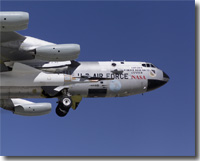X-43A STATUS UPDATE: Captive Carry Rehearsal Flight Successful; Mach 10 Free Flight Next
September 28, 2004
Release: 04-49

NASA aeronautics researchers are looking forward to flying the X-43A research aircraft at speeds up to 10 times the speed of sound later this fall, following a successful “captive carry” dress rehearsal flight from NASA’s Dryden Flight Research Center Sept. 27.
According to X-43A lead operations engineer David McAllister, who served as test director for the mission, the captive carry flight duplicated all operational functions of the planned 7,000-mph – or Mach 10 – flight and served as a training exercise for staff, except that the X-43A and its modified Pegasus booster were not released from NASA’s B-52B launch aircraft and their engines were not ignited.
“We have two primary purposes for doing a captive carry flight,” said McAllister. “The first is to make sure that the X-43 and its booster rocket – two highly complex systems – are ready for flight. The second is to make sure we’re well trained. It’s a very big operation (and) we want to make sure that all those people and all those systems are ready to go.”
The X-43A is powered by a revolutionary air-breathing supersonic-combustion ramjet – or “scramjet” – engine. If successful, the Mach 10 flight will break all speed records for an aircraft powered by an air-breathing engine.
After a review of captive-carry flight data, project engineers are expected to set a tentative date for the final X-43A flight for early November.
The X-43A project is part of the Hyper-X hypersonic research program led by NASA’s Aeronautics Research Mission Directorate and operated jointly by NASA’s Langley Research Center, Hampton, Va., and Dryden Flight Research Center, Edwards, Calif. The program aims to demonstrate air-breathing engine technologies that promise to increase payload capacity – or reduce vehicle size for the same payload – for future hypersonic aircraft and reusable space launch vehicles.
Editors: Photos to support this release are available in publication-quality resolution at: /centers/dfrc/Gallery/Photo/X-43A/index.html
Captions: ED04-0261-01, ED04-0261-02 – NASA’s B-52B launch aircraft takes off carrying the third X-43A hypersonic research vehicle on a captive-carry evaluation flight Sept. 27, 2004.
A short video clip of the captive carry mission is available on line at: /centers/dfrc/Gallery/Movie/Hyper-X/HTML/EM-0015-11.html
For further information about the X-43A and NASA’s Hyper-X hypersonic research program on the Internet, log on to: https://www.nasa.gov/missions/research/x43-main.html
For more information about NASA aeronautics research on the Internet, visit: http://www.aeronautics.nasa.gov/
-NASA-


























